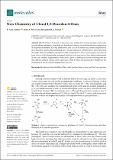New chemistry of chiral 1,3-dioxolan-4-ones
Abstract
(2S,5S)-5-Phenyl-2-t-butyl-1,3-dioxolan-4-one, readily derived from mandelic acid, undergoes Michael addition to butenolide and 4-methoxy-β-nitrostyrene with the absolute configuration of the products confirmed by X-ray diffraction in each case. In the former case thermal fragmentation gives the phenyl ketone thus illustrating use of the dioxolanone as a chiral benzoyl anion equivalent. The Diels–Alder cycloaddition chemistry of (2S)-5-methylene-2-t-butyl-1,3-dioxolan-4-one, derived from lactic acid, has been further examined with X-ray structures of four adducts determined. In one case thermal fragmentation of the adduct gives a chiral epoxy ketone resulting from the dioxolanone acting as a chiral ketene equivalent, while in others the products give insight into the mechanism of the dioxolanone fragmentation process.
Citation
Aitken , R A , Power , L A & Slawin , A M Z 2023 , ' New chemistry of chiral 1,3-dioxolan-4-ones ' , Molecules , vol. 28 , no. 9 , 3845 . https://doi.org/10.3390/molecules28093845
Publication
Molecules
Status
Peer reviewed
ISSN
1420-3049Type
Journal article
Description
Funding: Authors thank the School of Chemistry for a studentship to L. A. P.Collections
Items in the St Andrews Research Repository are protected by copyright, with all rights reserved, unless otherwise indicated.

